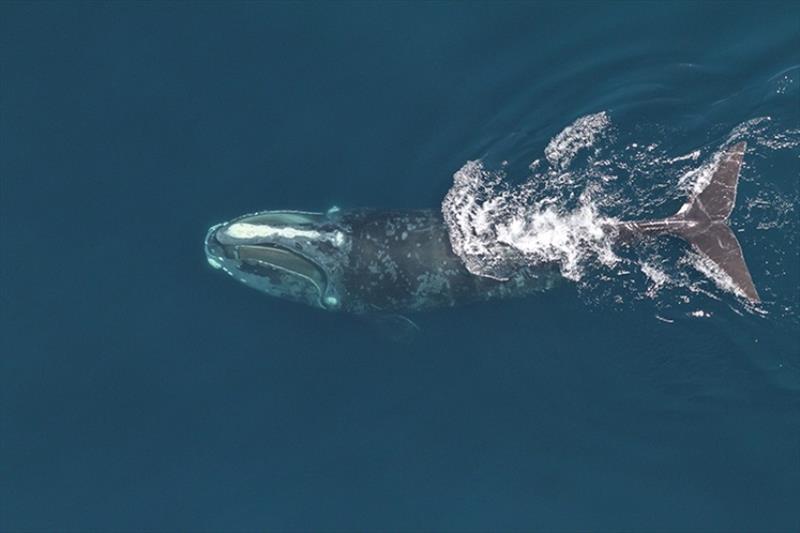
Reducing entanglements & vessel strikes makes extinction less likely for North Atlantic right whales
by NOAA Fisheries 26 Oct 2023 19:38 UTC

North Atlantic right whale feeding © NOAA Fisheries / Christin Khan
NOAA Fisheries has released a comprehensive population viability analysis for endangered North Atlantic right whales. Results show that both vessel strikes and entanglement of these whales need to be considerably reduced for the species to continue to exist.
This analysis was developed through the NOAA Fisheries North Atlantic Right Whale Implementation Teams established to assist with implementing the North Atlantic right whale recovery plan.
"This work demonstrates that significant reduction in mortality caused by both vessel strikes and entanglement is essential to reduce the probability of extinction," said study lead author Michael Runge, a research ecologist at the U.S. Geological Survey.
Threats considered in this assessment are:
- Entanglement in fishing gear
- Vessel strikes (collisions between whales and vessels)
- Changes in prey abundance and availability
"This tool does not estimate or predict actual risk reduction likely for a prescribed management measure such as weak links in gear or reduced vessel speeds," said study co-author Daniel Linden. "Instead it helps those making decisions and recommendations understand how the North Atlantic right whale population is likely to respond over time if deaths and injuries from various threats are reduced by target amounts." Linden is a NOAA Fisheries research statistician.
By looking at each threat separately, researchers were also able to evaluate their relative effect on population numbers. Reductions in entanglement had the most influence, followed closely by reducing vessel strikes. Changes in prey abundance compared to historical patterns had a smaller effect.
Results indicate that reducing either entanglement risk or vessel strike risk by 25 percent reduced the probability of quasi-extinction to 71 percent and 85percent, respectively. Reducing both by 25 percent results in a 53 percent probability of quasi-extinction.
The tool can also consider combinations of threat reduction. For example, addressing both entanglement and vessel strikes had the greatest positive effect on reducing the probability of quasi-extinction, more than addressing just one or the other of these threats.
"Quasi-extinction" is when animals are still present, but the population may no longer be able to recover because of inbreeding, difficulty in finding mates, and sensitivity to chance events. For this assessment, the quasi-extinction threshold is fewer than 50 reproductively successful females in the population after 100 years.
A five-year collaboration and plans for improvements
Development of a population viability analysis supports NOAA's North Atlantic right whale recovery plan in the United States and Canada's recovery strategy. It was recommended in NOAA's 5-year review of North Atlantic right whale status.
It was developed over five years by a group of scientists from the United States and Canada, from state, federal, governmental, and private, non-profit institutions. In addition to NOAA Fisheries, these include:
- U.S. Geological Survey
- Florida Fish and Wildlife Conservation Commission
- U.S. Fish and Wildlife Service
- Anderson Cabot Center for Ocean Life at the New England Aquarium
- Fisheries and Oceans Canada
- Oceans Initiative
The Center for Independent Experts peer reviewed the draft analysis in 2022, and the authors considered review results in completing the final document. Additional documentation on the underlying models and the model code will be available in a public data repository to promote further development and improvements.
Earlier this year, we released a decision support tool. It can help quantify entanglement risk in U.S. waters during specific times in specific places using information about what has happened in the past. It helps those developing management measures estimate the relative effectiveness of a particular measure—for example, a change in gear configuration—intended to reduce entanglements.
The population viability analysis is focused on how range-wide (United States and Canada) survival and reproduction rates for these whales could change in the future as a threat is reduced by a targeted amount. It can help managers examine the relative magnitude of reduction needed in risk posed by a particular threat—such as entanglement or vessel strike—in order to have an effect on the population trajectory.
We will continue to collaborate with others on improving, adapting, and extending these tools as new data, new methods, and new questions arise. For example, the population viability analysis tool could be adapted to explore the effects of offshore wind energy development.
North Atlantic Right Whale Status
NOAA Fisheries and our partners are dedicated to conserving and rebuilding the endangered North Atlantic right whale population, which is approaching extinction.
Entanglement in fishing gear and vessel strikes are the leading causes of right whale deaths and serious injury in both U.S. and Canadian waters. Climate change is also affecting every aspect of their survival—changing their ocean habitat, their migratory patterns, the location and availability of their prey, and distribution of human-related threats. These changes are coinciding with decreasing whale health and reproduction rates, increasing their susceptibility to mortality or serious injury from entanglement and vessel strike.
The North Atlantic Right Whale Road to Recovery describes our efforts to halt the current population decline and recover the species.